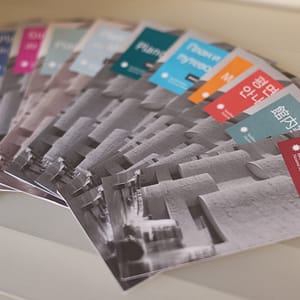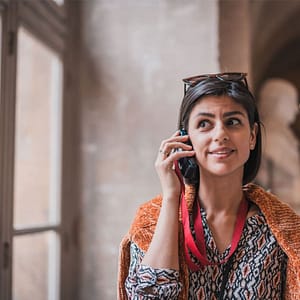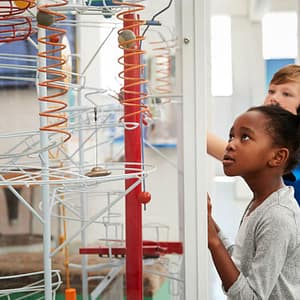Tourists and Locals: How Museums Can Translate for Both
From maps to audio tours, signage, and exhibition didactics—museums produce a wide variety of collateral that impact the visitor experience in different ways. This can make it a challenge to develop a comprehensive translation strategy and determine which languages to translate into.
One key factor that should be taken into account is the audience. When developing your translation strategy, begin by asking the question: Who is the audience for any specific exhibit or piece of collateral?
In this video, Director of Sales Will Lach and Director of Production Yasmin Menon tackle the subject by discussing the two key types of museum audiences: tourists and members of the local community. Will and Yasmin look at the ways each of these different audiences can inform translation decisions and guide language selection.
Translation Strategies: Starting With Museum Maps and Visitor Guides
Will and Yasmin begin their conversation by discussing maps and visitor guides. Upon entering a museum, all types of visitors are likely to pick up a map. But the extent to which they rely upon this resource to guide their visit will vary. A map can significantly impact the user experience for an out-of-town visitor who is unfamiliar with the museum layout and the exhibits. A translated map can help a tourist select which exhibits they want to see, help them find their way, and make them aware of the services offered by the museum.
Local residents, on the other hand, have a stronger likelihood of being repeat visitors. They may be at the museum for a lecture or special event. They might just want to see a special exhibit the museum had been advertising. While maps and visitor guides certainly serve as resources for both tourists and locals, the demographics of a museum’s tourists are more likely to guide language selection. Tourists are simply the group that typically relies more heavily on maps and visitor guides as a resource.
Identify Your Primary Audience for Upcoming Programming and Special Exhibits
Will and Yasmin continue the conversation by discussing programming as well as special exhibitions, and the different translation strategies a museum might take for each.
While there’s no one-size-fits-all approach, there are some questions museums can ask to begin making informed decisions about language selection.
- What are you producing and how will it be used to enhance the visitor experience?
- Who is the primary audience for any specific piece?
- How will translation support the content of the exhibit or program?
- Will translation support your institutional goals regarding inclusion and accessibility?
The type of material you are developing as well as the audience should be key factors guiding your translation strategy.
Census data can help you understand the demographics of your local community. You can get started here.
Transcript
Yasmin Menon: Hi, I’m Yasmin Menon, the director of production here at Eriksen Translations.
Will Lach: And I’m Will Lach, director of sales.
Yasmin Menon: Hi Will. Hi everybody. Today my topic of discussion is museums and how they decide which languages to translate their materials into for guests. Where should they start?
Will Lach: Where should they start? They should probably start by asking: whom are we translating for?
Yasmin Menon: And that would mean all guests, but it seems like you’re making a distinction here.
Will Lach: I am.
Yasmin Menon: All right… what would that be?
Will Lach: The big distinction would be between tourists and locals. They have different demographics.
Yasmin Menon: Great! So, give us an example of what would be created just for tourists and which languages that would be chosen.
Will Lach: Okay, if you’re a tourist and you’re now walking into a museum or botanical garden, what do you want when you step through those doors?
Yasmin Menon: I would first want to find my way around. A map!
Will Lach: Yes, you would want a map. Probably every tourist is going to pick one up. So will a few locals, but the locals are mostly going to go to the impressionists, or the mummies, or the bar.
Yasmin Menon: Right, that’s where we probably would go first. Coming back to the question… how does that trigger language choice? For tourists, where would you begin?
Will Lach: Visitor Services Departments would be a good place to start. They would know their visitors. Museums often start small with languages, like Spanish or Chinese. Or, when there are a lot of tourists, they start big with five to ten languages.
Yasmin Menon: Right. For the community, the people who live in the area, who are the “other type of visitor…” How is language choice triggered?
Will Lach: In large cities there are often going to be communities of people who don’t speak English at home. Museums want to attract multigenerational families for events like Day of the Dead or a Lunar New Year Festival—seasonal events, I guess you could call them.
Yasmin Menon: So, museums host cultural events that cater to their communities. Of course, it can’t be exclusive. There are tourists and community members. Is there an overlap in terms of the events produced by the museum?
Will Lach: I would say that special exhibitions are a big area of overlap because tourists are going to head straight to them. And locals are going to want to see them, because they don’t stay forever. So yeah, special exhibitions.
Yasmin Menon: Circling back to the same question, how are language decisions made for these special exhibits?
Will Lach: Often, it is decided by the topic matter. For instance, last year for the San Francisco Museum of Modern Art, we translated the Art and China exhibition into simplified Chinese. For the Frida Kahlo show at the North Carolina Museum of Art, we of course did Spanish. So it will often be subject matter that drives the language choice for special exhibitions.
Yasmin Menon: Great! What kind of data can museums collect to get information about the types of visitors that come to their museum?
Will Lach: For data about local visitors, the good old census is fantastic. You can see which languages people are speaking at home and where they come from. It’s pretty amazing.
Yasmin Menon: Great, Will! Thank you, as always, for such great information. Folks, get out there! Get those maps. Enjoy the museum in your own language. And museums, keep translating!
Will Lach: Bye bye.
 Named to the 2024 Inc. 5000 list of fastest-growing companies and ranked among the world’s top 100 language service providers by CSA Research
Named to the 2024 Inc. 5000 list of fastest-growing companies and ranked among the world’s top 100 language service providers by CSA Research

